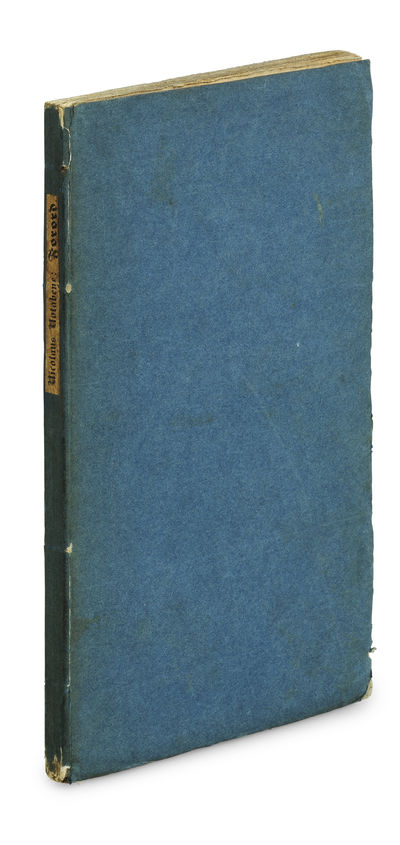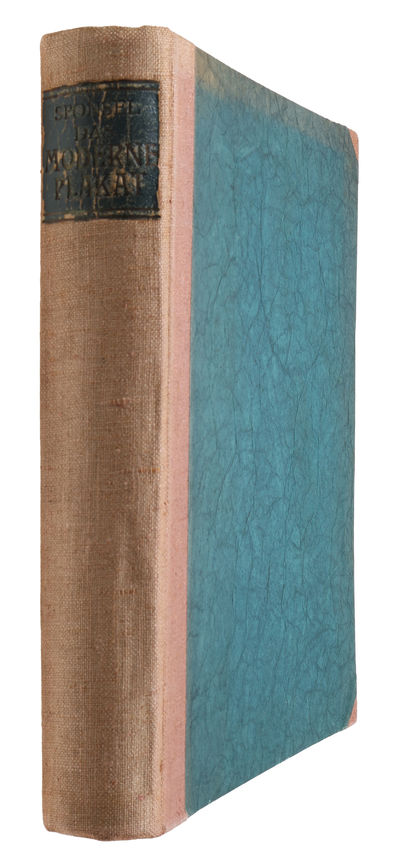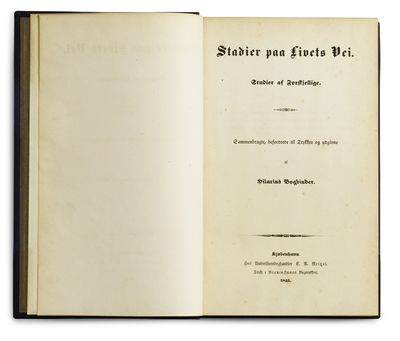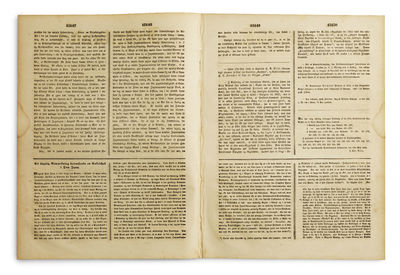THOMSON, JOHN (+) WILLIAM FLOYD (+) FELICE BEATO (+) HIPPOLYTE ARNOUX.
The Tordenskjold-expedition. 71 albumen prints from the 1860'ies to 1873. - [FINE COLLECTION OF EARLY PHOTOGRAPHS FROM EAST-ASIA DOCUMENTING THE LAYDOWN OF THE FIRST TELEGRAPH CABLES IN EAST-ASIA]
Herman H. J. Lynge & Søn A/S
lyn60283
1870-1872. Folio-oblong (395 x 320 mm). Original brown half calf, recased - the original cloth (with gilt lettering to the front) has been expertly mounted on to the new boards, and most of the original gilt leather spine has been preserved over a perfectly matching new lovely brown half calf. "Tordenskjold / 1870 - 1873" in gilt lettering, partly worn of, to front board. End-papers renewed. 71 albumen print in various sizes and by various photographers (see below) mounted on 59 contemporary white cardboard leaves (measuring 370 x 310 mm), all re-hinged. The album was water-damaged at some point, but has been expertly and neatly restored and appears in overall very good condition with good tones. 1, Oval photo of Tordenskjold (205 x 60mm) 2, Photo of Tordenskjold (190 x 143 mm) 3, Crew aboard Tordenskjold (200 x 14 mm) 4, Crew aboard Tordenskjold (157 x 128 mm) 5, Crew and equipment aboard Tordenskjold (228 x 176 mm) 6, Naval officers about Tordenskjold (167 x 130 mm). 7, 8 small photos of various places on one plate (274 x 190 mm) 8, The harbor of Port Said. By Hippolyte Arnoux (247 x 190mm) 9, Muddigging machines in the channel of Port Said. By Hippolyte Arnoux. (245 x 190mm) 10, Port Said. By Hippolyte Arnoux. 11, Malta (262 x 207 mm) 12, Two photos of Malta (each measuring 134 x 120 mm) 13, Two photos of Gibraltar (Each measuring 148 x 114) 14, Deep Water Bay, Hong Kong (194 x 130 mm). 15, Two photos depicting telegraph-house and ships in Deep Water Bay (each measuring 150 x 112) 16, Boat with people. By Felice Beato, coloured (294 x 235 mm) 17, House next to river. By John Thomson, December 1870 (278 x 225 mm) 17, Seamen’s hospital in Hong Kong. (261 x 190 mm) 18, Hong Kong. (270 x 195 mm) 19, Hong Kong, by Floyd (270 x 192 mm) 20, Hong Kong, by Floyd (240 x 190 mm) 21, Two photos of sites in Hong Kong (each measuring 165 x 127 mm) 22, Five Persians in Hong Kong (215 x 244 mm) 23, Group of women in Hong Kong, (326 x 215 mm) 24, Two photos of Hong Kong harbour, one photo depicting “Cella” (182 x 105; 130 x 98 mm) 25, Villa at Canton. (264 x 190 mm) 26, Pagode in Xuexiu Park, Guangdong. By William Pryor Floyd. (195 x 246 mm) 27, Boats in Canton. William Pryor Floyd,(270 x 223 mm) 28, Pou-Ting-Qua’s Garden, Canton. By John Thomson. (289 x 230 mm) 29, Fields in Canton. (205 x 155 mm) 30, Houses in Canton. (267 x 210 mm) 31, Canton harbor. By John Thomson. (245 x 202 mm) 32, Boat on the Canton river. (274 x 204 mm) 33, Wall around Canton. (260 x 200 mm). 34, Boats in Canton (293 x 225) 35, Telegraphstation in Woosung. (150 x 110 mm) 36, Boats in Foochow. (287 x 232 mm) 37, Temple in Foochow. By John Thomson (190 x 237 mm) 38, Pagode in Foochow. Presumably by John Thomson. (287 x 220 mm). 39, Tomb of Fou Tcheou. By John Thomson. (290 x 225 mm). 40, Temple in Shanghai. (237 x 188 mm). 41, Shanghai. (232 x 176 mm) 42, Chaochow bridge, Kwangtung. By John Thomson. (266 x 204 mm). 43. Panorama of Nagasaki consisting of two photos. (371 x142 mm) 44, Two photos of Nagasaki. Felice Beato. (Each measuring 169 x 119 mm). 45, Two photos from Nagasaki. Presumably by Felice Beato. (Each measuring 165 x 118 mm) 46, Two photos from Nagasaki. Presumably by Felice Beato. (Each measuring 165 x 118 mm) 47, Temple in Nagasaki. Presumably by Felice Beato. (169 x 118 mm). 48, Photo of Japanese woman in kimono. By Felice Beato. (205 x 255 mm). 49, Two photos of officers in house in Yokohama. (162 x 125 mm). 50, The Abbot and Monks of Kushan Monastery. By John Thomson. (287 x 204 mm). 51, Wooden structure, presumably Nagasaki. Presumably by Felice Beato. (270 x 208 mm) 52, Pagode, presumably Nagasaki. Presumably by Felice Beato. (234 x 185 mm) 53, Cityscape with lake, presumably Nagasaki. Presumably by Felice Beato.. (280 x 228 mm). 54, Two photos, cemetery and stairs to temple. By Felice Beato. (Each measuring 168 x 118 mm). 55, People standing outside house, presumably Hong Kong. By John Thomson. (185 x 155 mm) 56, Guangzhou Great Norh Gate, Canton. By John Thomson (245 x 156 mm). 57, Two photos, one of the building of a telegraph station (presumably in Wladivostok) and a view of Wladivostok from the sea (154 x 123; 130 x 99 mm). 58, Seascape of two ships. (130 x 140 mm). 59, Ship laying for anchor. (170 x 123 mm)
Exceedingly rare photo-album documenting the Danish vessel Tordenskjold’s mission in laying the very first telegraph cables in East Asia thereby connecting China and Japan to the global telegraph system. The album consists of photos taken aboard the vessel Tordenskjold, of Tordenskjold itself along with its crew, by an unknown photographer, and of photographs of the visited cities and surrounding areas by some of the finest photographers operating in East Asia at the time, such as John Thomson, William Floyd, Felice Beato and, in Egypt, Hippolyte Arnoux - all photographs presumably brought home by William Lund, Captain on board Tordenskjold. Through some of the earliest photos taken in China, Japan, and of the excavation of the Suez Canal, the present album depicts a pivotal moment in international relations and communications. Submarine telegraph cables were first brought to China by Danish magnate Carl Fredrick Tietgen (1829-1901), who in 1870 set up the Great Northern China and Japan Extension Company. The company was created to build and operate a telegraph cable connecting Hong Kong, Shanghai, and Japan, continuing on to Vladivostok on Russia's East coast. From Vladivostok, a cable ran along the Trans-Siberian Railway, linking Hong Kong to telegraph networks in Britain, Europe, and America. Tietgen fought off strong competition - primarily English-, and eventually won the concession to lay and operate new telegraph cables connecting Russia, China and Japan. Tietgen and his partners had embarked upon a grand and risky project. Undersea cables would need to be laid in waters that had not been sounded, cables were to be brought ashore on coasts where the prevailing conditions were not known, and it was uncertain whether the respective governments would grant permission. Everything – cables, stations, wire, and apparatus – was to be brought from Europe and had to function as a coherent system. Two chartered English steamships ‘Cella’ and ‘Great Northern’ were to transport and lay the cables, and the propeller-driven Danish frigate ‘Tordenskjold’ was to sound the waters near Nagasaki and Vladivostok, it had to also carry a relatively small amount of cables, and it was to keep away uninvited guests (of which there were plenty in the South China Sea). “As a small nation with negligible military resources, Denmark could provide a useful – politically neutral – centre for telegraph links to major European powers such as Britain, Russia and the emerging new power of Prussia. The Danes were able to utilize the technical know-how which had been accumulated with great difficulty, and occasionally heavy economic losses, in the preceding decades by British and American entrepreneurs. The competition between the Danish and British groups of telegraph entrepreneurs for first access to the Chinese market was preliminarily resolved when the directors of the two companies negotiated a secret agreement in May 1870. The Danish group had acquired an advantage in terms of timing by winning the Russian concession in 1869, and had to cover shorter distances by sea cables from Vladivostok to Nagasaki and Shanghai. But the British group had the advantage of better access to capital and a more extensive technical experience with submarine cable manufacture and operation. The essence of the agreement was that the line between Hong Kong and Shanghai should be established and operated by the Great Northern; the companies would share the income for telegrams which passed this section of the line and they would run offices in Hong Kong and Shanghai jointly. The agreement provided the Danes with assured landing rights in Hong Kong and with British diplomatic support for attempts to secure landing rights in China. Permission to bring submarine telegraph cables into Chinese treaty ports was obtained in 1870 from the Chinese Government (i.e., the office of foreign affairs, known as the Zongli Yamen) by the British Minister in Peking, Thomas Wade. At the same time, the Danish government had dispatched a diplomatic envoy, Chamberlain Julius Sick, at the Great Northern’s expense to China and Japan to obtain the necessary concessions. The cable between Hong Kong and Shanghai was laid in 1870–1871 with the assistance of the frigate Tordenskjold, which the Danish government had generously allocated to the task. The Great Northern had a great deal of technical problems with the cables they had bought from the British manufacturer since the quality of the insulation was not as good as expected. Therefore, the official opening of the line between Shanghai and Hong Kong was delayed until April 1871. During the remainder of that year the company struggled to finish cable sections from Shanghai to Nagasaki, and from Nagasaki to Vladivostok. Communication between Shanghai and Europe via these cables and the Russian Siberian lines was officially inaugurated on 1 January 1872.” (Erik Baark: Wires, Codes and People The Great Northern Telegraph Company in China 1870–90) The album covers and illustrates one on the most fascinating periods in the process of internationalization in the late modern period: The Suez Canal had just opened and ‘Tordenskjold’ was the first Danish ship to sail through it. The submarine cables linked the major hubs in East Asia to the Western world and helped facilitate an unprecedented growth in the region. Overall, the laying of the submarine cable in 1870-71 was a transformative event for East Asia in general. It played a critical role in the area's economic and social development, helping to make it the global commercial center it is today.
Exceedingly rare photo-album documenting the Danish vessel Tordenskjold’s mission in laying the very first telegraph cables in East Asia thereby connecting China and Japan to the global telegraph system. The album consists of photos taken aboard the vessel Tordenskjold, of Tordenskjold itself along with its crew, by an unknown photographer, and of photographs of the visited cities and surrounding areas by some of the finest photographers operating in East Asia at the time, such as John Thomson, William Floyd, Felice Beato and, in Egypt, Hippolyte Arnoux - all photographs presumably brought home by William Lund, Captain on board Tordenskjold. Through some of the earliest photos taken in China, Japan, and of the excavation of the Suez Canal, the present album depicts a pivotal moment in international relations and communications. Submarine telegraph cables were first brought to China by Danish magnate Carl Fredrick Tietgen (1829-1901), who in 1870 set up the Great Northern China and Japan Extension Company. The company was created to build and operate a telegraph cable connecting Hong Kong, Shanghai, and Japan, continuing on to Vladivostok on Russia's East coast. From Vladivostok, a cable ran along the Trans-Siberian Railway, linking Hong Kong to telegraph networks in Britain, Europe, and America. Tietgen fought off strong competition - primarily English-, and eventually won the concession to lay and operate new telegraph cables connecting Russia, China and Japan. Tietgen and his partners had embarked upon a grand and risky project. Undersea cables would need to be laid in waters that had not been sounded, cables were to be brought ashore on coasts where the prevailing conditions were not known, and it was uncertain whether the respective governments would grant permission. Everything – cables, stations, wire, and apparatus – was to be brought from Europe and had to function as a coherent system. Two chartered English steamships ‘Cella’ and ‘Great Northern’ were to transport and lay the cables, and the propeller-driven Danish frigate ‘Tordenskjold’ was to sound the waters near Nagasaki and Vladivostok, it had to also carry a relatively small amount of cables, and it was to keep away uninvited guests (of which there were plenty in the South China Sea). “As a small nation with negligible military resources, Denmark could provide a useful – politically neutral – centre for telegraph links to major European powers such as Britain, Russia and the emerging new power of Prussia. The Danes were able to utilize the technical know-how which had been accumulated with great difficulty, and occasionally heavy economic losses, in the preceding decades by British and American entrepreneurs. The competition between the Danish and British groups of telegraph entrepreneurs for first access to the Chinese market was preliminarily resolved when the directors of the two companies negotiated a secret agreement in May 1870. The Danish group had acquired an advantage in terms of timing by winning the Russian concession in 1869, and had to cover shorter distances by sea cables from Vladivostok to Nagasaki and Shanghai. But the British group had the advantage of better access to capital and a more extensive technical experience with submarine cable manufacture and operation. The essence of the agreement was that the line between Hong Kong and Shanghai should be established and operated by the Great Northern; the companies would share the income for telegrams which passed this section of the line and they would run offices in Hong Kong and Shanghai jointly. The agreement provided the Danes with assured landing rights in Hong Kong and with British diplomatic support for attempts to secure landing rights in China. Permission to bring submarine telegraph cables into Chinese treaty ports was obtained in 1870 from the Chinese Government (i.e., the office of foreign affairs, known as the Zongli Yamen) by the British Minister in Peking, Thomas Wade. At the same time, the Danish government had dispatched a diplomatic envoy, Chamberlain Julius Sick, at the Great Northern’s expense to China and Japan to obtain the necessary concessions. The cable between Hong Kong and Shanghai was laid in 1870–1871 with the assistance of the frigate Tordenskjold, which the Danish government had generously allocated to the task. The Great Northern had a great deal of technical problems with the cables they had bought from the British manufacturer since the quality of the insulation was not as good as expected. Therefore, the official opening of the line between Shanghai and Hong Kong was delayed until April 1871. During the remainder of that year the company struggled to finish cable sections from Shanghai to Nagasaki, and from Nagasaki to Vladivostok. Communication between Shanghai and Europe via these cables and the Russian Siberian lines was officially inaugurated on 1 January 1872.” (Erik Baark: Wires, Codes and People The Great Northern Telegraph Company in China 1870–90) The album covers and illustrates one on the most fascinating periods in the process of internationalization in the late modern period: The Suez Canal had just opened and ‘Tordenskjold’ was the first Danish ship to sail through it. The submarine cables linked the major hubs in East Asia to the Western world and helped facilitate an unprecedented growth in the region. Overall, the laying of the submarine cable in 1870-71 was a transformative event for East Asia in general. It played a critical role in the area's economic and social development, helping to make it the global commercial center it is today.
Adress:
Silkegade 11
DK-1113 Copenhagen Denmark
Telefon:
CVR/VAT:
DK 16 89 50 16
E-post:
Webb:
![The Tordenskjold-expedition. 71 albumen prints from the 1860'ies to 1873. - [FINE COLLECTION OF EARLY PHOTOGRAPHS FROM EAST-ASIA DOCUMENTING THE LAYDOWN OF THE FIRST TELEGRAPH CABLES IN EAST-ASIA] (photo 1)](https://d3525k1ryd2155.cloudfront.net/h/356/991/1527991356.0.l.0.jpg)
![The Tordenskjold-expedition. 71 albumen prints from the 1860'ies to 1873. - [FINE COLLECTION OF EARLY PHOTOGRAPHS FROM EAST-ASIA DOCUMENTING THE LAYDOWN OF THE FIRST TELEGRAPH CABLES IN EAST-ASIA] (photo 2)](https://d3525k1ryd2155.cloudfront.net/h/356/991/1527991356.1.l.0.jpg)
![The Tordenskjold-expedition. 71 albumen prints from the 1860'ies to 1873. - [FINE COLLECTION OF EARLY PHOTOGRAPHS FROM EAST-ASIA DOCUMENTING THE LAYDOWN OF THE FIRST TELEGRAPH CABLES IN EAST-ASIA] (photo 3)](https://d3525k1ryd2155.cloudfront.net/h/356/991/1527991356.2.l.0.jpg)
![The Tordenskjold-expedition. 71 albumen prints from the 1860'ies to 1873. - [FINE COLLECTION OF EARLY PHOTOGRAPHS FROM EAST-ASIA DOCUMENTING THE LAYDOWN OF THE FIRST TELEGRAPH CABLES IN EAST-ASIA] (photo 4)](https://d3525k1ryd2155.cloudfront.net/h/356/991/1527991356.3.l.0.jpg)
![The Tordenskjold-expedition. 71 albumen prints from the 1860'ies to 1873. - [FINE COLLECTION OF EARLY PHOTOGRAPHS FROM EAST-ASIA DOCUMENTING THE LAYDOWN OF THE FIRST TELEGRAPH CABLES IN EAST-ASIA] (photo 5)](https://d3525k1ryd2155.cloudfront.net/h/356/991/1527991356.4.l.0.jpg)
![The Tordenskjold-expedition. 71 albumen prints from the 1860'ies to 1873. - [FINE COLLECTION OF EARLY PHOTOGRAPHS FROM EAST-ASIA DOCUMENTING THE LAYDOWN OF THE FIRST TELEGRAPH CABLES IN EAST-ASIA] (photo 6)](https://d3525k1ryd2155.cloudfront.net/h/356/991/1527991356.5.l.0.jpg)
![The Tordenskjold-expedition. 71 albumen prints from the 1860'ies to 1873. - [FINE COLLECTION OF EARLY PHOTOGRAPHS FROM EAST-ASIA DOCUMENTING THE LAYDOWN OF THE FIRST TELEGRAPH CABLES IN EAST-ASIA] (photo 7)](https://d3525k1ryd2155.cloudfront.net/h/356/991/1527991356.6.l.0.jpg)
![The Tordenskjold-expedition. 71 albumen prints from the 1860'ies to 1873. - [FINE COLLECTION OF EARLY PHOTOGRAPHS FROM EAST-ASIA DOCUMENTING THE LAYDOWN OF THE FIRST TELEGRAPH CABLES IN EAST-ASIA] (photo 8)](https://d3525k1ryd2155.cloudfront.net/h/356/991/1527991356.7.l.0.jpg)
![The Tordenskjold-expedition. 71 albumen prints from the 1860'ies to 1873. - [FINE COLLECTION OF EARLY PHOTOGRAPHS FROM EAST-ASIA DOCUMENTING THE LAYDOWN OF THE FIRST TELEGRAPH CABLES IN EAST-ASIA] (photo 9)](https://d3525k1ryd2155.cloudfront.net/h/356/991/1527991356.8.l.0.jpg)
![The Tordenskjold-expedition. 71 albumen prints from the 1860'ies to 1873. - [FINE COLLECTION OF EARLY PHOTOGRAPHS FROM EAST-ASIA DOCUMENTING THE LAYDOWN OF THE FIRST TELEGRAPH CABLES IN EAST-ASIA] (photo 10)](https://d3525k1ryd2155.cloudfront.net/h/356/991/1527991356.9.l.0.jpg)
![The Tordenskjold-expedition. 71 albumen prints from the 1860'ies to 1873. - [FINE COLLECTION OF EARLY PHOTOGRAPHS FROM EAST-ASIA DOCUMENTING THE LAYDOWN OF THE FIRST TELEGRAPH CABLES IN EAST-ASIA] (photo 11)](https://d3525k1ryd2155.cloudfront.net/h/356/991/1527991356.10.l.0.jpg)
![The Tordenskjold-expedition. 71 albumen prints from the 1860'ies to 1873. - [FINE COLLECTION OF EARLY PHOTOGRAPHS FROM EAST-ASIA DOCUMENTING THE LAYDOWN OF THE FIRST TELEGRAPH CABLES IN EAST-ASIA] (photo 12)](https://d3525k1ryd2155.cloudfront.net/h/356/991/1527991356.11.l.0.jpg)
![The Tordenskjold-expedition. 71 albumen prints from the 1860'ies to 1873. - [FINE COLLECTION OF EARLY PHOTOGRAPHS FROM EAST-ASIA DOCUMENTING THE LAYDOWN OF THE FIRST TELEGRAPH CABLES IN EAST-ASIA] (photo 13)](https://d3525k1ryd2155.cloudfront.net/h/356/991/1527991356.12.l.0.jpg)
![The Tordenskjold-expedition. 71 albumen prints from the 1860'ies to 1873. - [FINE COLLECTION OF EARLY PHOTOGRAPHS FROM EAST-ASIA DOCUMENTING THE LAYDOWN OF THE FIRST TELEGRAPH CABLES IN EAST-ASIA] (photo 14)](https://d3525k1ryd2155.cloudfront.net/h/356/991/1527991356.13.l.0.jpg)
![The Tordenskjold-expedition. 71 albumen prints from the 1860'ies to 1873. - [FINE COLLECTION OF EARLY PHOTOGRAPHS FROM EAST-ASIA DOCUMENTING THE LAYDOWN OF THE FIRST TELEGRAPH CABLES IN EAST-ASIA] (photo 15)](https://d3525k1ryd2155.cloudfront.net/h/356/991/1527991356.14.l.0.jpg)
![The Tordenskjold-expedition. 71 albumen prints from the 1860'ies to 1873. - [FINE COLLECTION OF EARLY PHOTOGRAPHS FROM EAST-ASIA DOCUMENTING THE LAYDOWN OF THE FIRST TELEGRAPH CABLES IN EAST-ASIA] (photo 16)](https://d3525k1ryd2155.cloudfront.net/h/356/991/1527991356.15.l.0.jpg)
![The Tordenskjold-expedition. 71 albumen prints from the 1860'ies to 1873. - [FINE COLLECTION OF EARLY PHOTOGRAPHS FROM EAST-ASIA DOCUMENTING THE LAYDOWN OF THE FIRST TELEGRAPH CABLES IN EAST-ASIA] (photo 17)](https://d3525k1ryd2155.cloudfront.net/h/356/991/1527991356.16.l.0.jpg)
![The Tordenskjold-expedition. 71 albumen prints from the 1860'ies to 1873. - [FINE COLLECTION OF EARLY PHOTOGRAPHS FROM EAST-ASIA DOCUMENTING THE LAYDOWN OF THE FIRST TELEGRAPH CABLES IN EAST-ASIA] (photo 18)](https://d3525k1ryd2155.cloudfront.net/h/356/991/1527991356.17.l.0.jpg)
![The Tordenskjold-expedition. 71 albumen prints from the 1860'ies to 1873. - [FINE COLLECTION OF EARLY PHOTOGRAPHS FROM EAST-ASIA DOCUMENTING THE LAYDOWN OF THE FIRST TELEGRAPH CABLES IN EAST-ASIA] (photo 19)](https://d3525k1ryd2155.cloudfront.net/h/356/991/1527991356.18.l.0.jpg)





